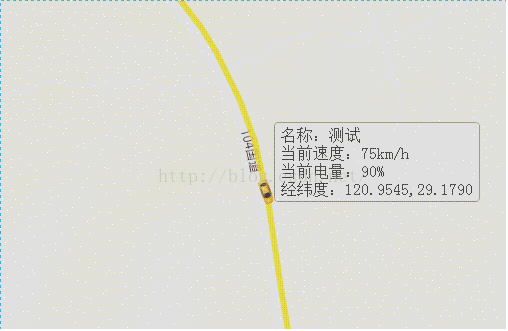一、.在div中使用CSS3动画,以overlay的形式添加
1.先为一个div创建css
[css] view plain copy print? .css_animation{ height:50px; 50px; border-radius: 25px; background: rgba(255, 0, 0, 0.9); transform: scale(0); animation: myfirst 3s; animation-iteration-count: infinite; } @keyframes myfirst{ to{ transform: scale(2); background: rgba(0, 0, 0, 0); } }
2.动态创建这个div,并将这个div作为overlay的Element,添加到地图中
var point_div = document.createElement('div'); point_div.className="css_animation"; point_overlay = new ol.Overlay({ element: point_div, positioning: 'center-center' }); map.addOverlay(point_overlay);
如果需要添加到地图上,只需要设置
point_overlay.setPosition(coordinate);
二、使用openlayers3自带的postcompose事件
这个事件在地图渲染时都会触发,而我们只要改变地图上的某个feature或者layer或者其他任何东西,就会触发重新渲染。因此我们在postcompose中改变feature的样式,改变样式后重新触发postcompose事件,一只循环下去,形成动画效果。这里我们制作了一个闪烁的动画,代码如下:
var radius = 0; map.on('postcompose', function(){ // 增大半径,最大30 radius++; radius = radius%30; var color; if(radius <15){ color = '#FF0000' }else{ color = null } gpsPointLayer.setStyle(new ol.style.Style({ image: new ol.style.Icon({ anchor: [0.5, 1], src: 'IMG/online.png', color: color }) })); })
其中radius每次postcompose都会自增,用以控制样式改变的速度
下面代码跟上面代码实现的功能差不多
<div id="map" style=" 100%"></div>
<script type="text/javascript">
var layer = new ol.layer.Vector({
source: new ol.source.Vector()
})
var map = new ol.Map({
layers: [
new ol.layer.Tile({
source: new ol.source.OSM()
}),
layer
],
target: 'map',
view: new ol.View({
center: ol.proj.transform(
[104, 30], 'EPSG:4326', 'EPSG:3857'),
zoom: 10
})
});
var circle = new ol.Feature({
geometry: new ol.geom.Point(ol.proj.transform(
[104, 30], 'EPSG:4326', 'EPSG:3857'))
});
circle.setStyle(new ol.style.Style({
image: new ol.style.Circle({
radius: 0,
stroke: new ol.style.Stroke({
color: 'red',
size: 1
})
})
}));
layer.getSource().addFeature(circle);
// 关键的地方在此:监听postcompose事件,在里面重新设置circle的样式
var radius = 0;
map.on('postcompose', function(){
// 增大半径,最大20
radius++;
radius = radius % 20;
// 设置样式
circle.setStyle(new ol.style.Style({
image: new ol.style.Circle({
radius: radius,
stroke: new ol.style.Stroke({
color: 'red',
size: 1
})
})
}));
})
</script>
三、使用js的requestAnimationFrame
requestAnimationFrame的方式与其他的js中方法相比的优势如下:1.经过浏览器优化,动画更流畅2.窗口没激活时,动画将停止,省计算资源3.更省电,尤其是对移动终端。这里我们制作了一个轨迹回放的动画。代码如下:
var progress = 0; var moveFeature2 = function(){ var speed = 200; progress += 1; if(progress%speed==0){ var currentPoint = new ol.geom.Point(routeCoords[progress/speed]); var dx = routeCoords[progress/speed][0] - routeCoords[progress/speed-1][0]; var dy = routeCoords[progress/speed][1] - routeCoords[progress/speed-1][1]; var rotation = Math.atan2(dy, dx); var styleGeomarker = new ol.style.Style({ image: new ol.style.Icon({ src: 'images/taxi.png', rotateWithView: false, rotation: -rotation })}) var feature = new ol.Feature(currentPoint); vectorLayer2.getSource().clear(); vectorLayer2.getSource().addFeature(feature); vectorLayer2.setStyle(styleGeomarker); } if(progress%speed!=0){ var arcGenerator = new arc.GreatCircle( {x: routeCoords[Math.floor(progress/speed)][0], y: routeCoords[Math.floor(progress/speed)][1]}, {x: routeCoords[Math.floor(progress/speed+1)][0], y: routeCoords[Math.floor(progress/speed+1)][1]}); var arcLine = arcGenerator.Arc(speed, {offset: 0});//在两个点之间生成100个点 js地址为https://api.mapbox.com/mapbox.js/plugins/arc.js/v0.1.0/arc.js var line = new ol.geom.LineString(arcLine.geometries[0].coords); var lineFeature = new ol.Feature({ type: 'route', geometry: line }); var currentPoint = new ol.geom.Point(arcLine.geometries[0].coords[progress%speed]); var dx = arcLine.geometries[0].coords[progress%speed][0] - arcLine.geometries[0].coords[progress%speed-1][0]; var dy = arcLine.geometries[0].coords[progress%speed][1] - arcLine.geometries[0].coords[progress%speed-1][1]; var rotation = Math.atan2(dy, dx); var styleGeomarker = new ol.style.Style({ image: new ol.style.Icon({ src: 'images/taxi.png', rotateWithView: false, rotation: -rotation })}) var feature = new ol.Feature(currentPoint); vectorLayer2.getSource().clear(); vectorLayer2.getSource().addFeature(feature); helpTooltipElement.innerHTML="名称:测试"+"\<br\>" +"当前速度:75km/h"+"\<br\>" +"当前电量:90%"+"\<br\>" +"经纬度:"+(arcLine.geometries[0].coords[progress%100][0]+"").substring(0,8)+","+(arcLine.geometries[0].coords[progress%100][1]+"").substring(0,7); helpTooltip.setPosition(arcLine.geometries[0].coords[progress%100]); } if (progress/speed < routeLength-1) { requestAnimationFrame(moveFeature2); } } 此处涉及openlayers3中弹出框overlay、layer、feature、style,还有一个外部引用的工具js(地址文中已给出)以及requestAnimationFrame,细节不再叙述,效果如下,下班了。。。
此处涉及openlayers3中弹出框overlay、layer、feature、style,还有一个外部引用的工具js(地址文中已给出)以及requestAnimationFrame,细节不再叙述

OpenLayers 3内置的动画效果,代码如下:
<div id="map" style=" 100%"></div>
<!--增加两个按钮,一个演示不带动画,一个演示带动画-->
<input type="button" value="回到原点-不带动画" onclick="backNoAnim()"></input>
<input type="button" value="回到原点-带动画" onclick="backWithAnim()"></input>
<script type="text/javascript">
var map = new ol.Map({
layers: [
new ol.layer.Tile({
source: new ol.source.OSM()
})
],
target: 'map',
view: new ol.View({
center: ol.proj.transform(
[104, 30], 'EPSG:4326', 'EPSG:3857'),
zoom: 10
})
});
// 不带动画的实现
function backNoAnim() {
map.getView().setCenter(ol.proj.transform([104, 30], 'EPSG:4326', 'EPSG:3857'));
}
// 带动画的实现
function backWithAnim() {
// 注意: 应用内置的动画,实现平移动画
var pan = ol.animation.pan({
duration: 2000,
source: map.getView().getCenter()
});
// 注意: 使用beforeRender来添加
map.beforeRender(pan);
// 然后才是重新设置地图中心点到原来的位置
map.getView().setCenter(ol.proj.transform([104, 30], 'EPSG:4326', 'EPSG:3857'));
}
</script>
关键的代码始终在最后,结合注释,应该可以理解。 我们使用的内置动画是ol.animation.pan,用于平移动画,更详细的信息请参考官网API。 可以看到它是一个函数,返回一个ol.PreRenderFunction,添加到ol.Map,从而在渲染的时候使用,实现动画。
除了上面应用的动画之外,还有一些内置的动画,都在ol.animation里面,从官网API可以看到,包括:
ol.animation.bounce: 来回弹。ol.animation.pan: 平移。ol.animation.rotate: 旋转。ol.animation.zoom: 缩放。- 虽然内置动画并不多,但是细心的同学已经发现了内置动画有个参数
easing,这是一个强大的参数,因为可以让开发者自定义动画实现,从而实现动画效果的扩展。 其实已经内置了一些相关的实现,在ol.easing里面,涉及到一些常用的效果,包括: ol.easing.easeIn: 加速ol.easing.easeOut: 减速ol.easing.inAndOut: 先加速再减速ol.easing.linear: 匀速ol.easing.upAndDown: 和inAndOut类似-
<div id="map" style=" 100%"></div> <!--添加动画效果选择项--> <select id = "easing-type"> <option>easeIn</option> <option>easeOut</option> <option>inAndOut</option> <option>linear</option> <option>upAndDown</option> </select> <input type="button" value="回到原点" onclick="backWithAnim()"></input> <script type="text/javascript"> var map = new ol.Map({ layers: [ new ol.layer.Tile({ source: new ol.source.OSM() }) ], target: 'map', view: new ol.View({ center: ol.proj.transform( [104, 30], 'EPSG:4326', 'EPSG:3857'), zoom: 10 }) }); // 根据选择项,返回对应的动画,供下面的backWithAnim函数使用 function getEasing() { var typeSelect = document.getElementById('easing-type'); var easing = typeSelect.options[typeSelect.selectedIndex].text; if (easing === 'easeIn') { return ol.easing.easeIn; } else if (easing === 'easeOut') { return ol.easing.easeOut; } else if (easing === 'inAndOut') { return ol.easing.inAndOut; } else if (easing === 'linear') { return ol.easing.linear; } else if (easing === 'upAndDown') { return ol.easing.upAndDown; } } function backWithAnim() { var pan = ol.animation.pan({ duration: 2000, source: map.getView().getCenter(), easing: getEasing() // 设置对应选择的动画 }); map.beforeRender(pan); map.getView().setCenter(ol.proj.transform([104, 30], 'EPSG:4326', 'EPSG:3857')); } </script>通过上面这种方法,我们完全可以自定义动画函数,通过官网API文档可知,这些函数有一个参数
t,范围在0-1之间,然后函数返回一个0-1之间的数。 结合动画业务来看,虽然官网没有说明参数表示什么意思,但是我们可以猜测它就是时间,返回的值应该目标达成比。 下面我们自己来实现一个sin曲线式的动画:
<div id="map2" style=" 100%"></div>
<input type="button" value="回到原点" onclick="backWithAnim2();"></input>
<script type="text/javascript">
var map2 = new ol.Map({
layers: [
new ol.layer.Tile({
source: new ol.source.OSM()
})
],
target: 'map2',
view: new ol.View({
center: ol.proj.transform(
[104, 30], 'EPSG:4326', 'EPSG:3857'),
zoom: 10
})
});
// sin曲线动画
function sin(t) {
// 使用sin曲线公式
return Math.sin(t * Math.PI / 2);
}
function backWithAnim2() {
var pan = ol.animation.pan({
duration: 2000,
source: map2.getView().getCenter(),
easing: sin // 应用sin曲线动画
});
map2.beforeRender(pan);
map2.getView().setCenter(ol.proj.transform([104, 30], 'EPSG:4326', 'EPSG:3857'));
}
</script>